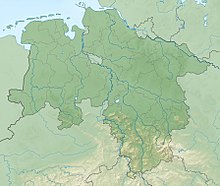Königsmoor (Moor)
Coordinates: 53 ° 24 ′ 49 ″ N , 8 ° 36 ′ 21 ″ E
The Königsmoor near Schwegen is located south of the NSG Stoteler Moor and is largely owned by the Cuxhaven district . An area of 13 hectares of grassland was bought by the State of Lower Saxony in 2002, and another area in 2007.
The nature reserves Königsmoor, Plackenmoor bei Schwegen and the Stoteler Moor merge in terms of area and are managed by the nature conservation authority (s) as the Hahnenknooper Moore nature reserve . They were also designated as FFH area no. 025 (Placken-, Königs- and Stoteler Moor).
General
The NSG Königsmoor currently covers 230 ha. Since the soil locations vary, there are moor and sand heaths in the area with transitions to birch-moor forest and oak-beech forest. Also thickets of bog bush and bog lilies -Torfmoos-Pagans are available. In a northerly direction it connects to the moor areas of the Stoteler Moor, in a southerly direction the nature reserve ends on a ridge .
Waterlogging
An area of approx. 80 ha was dammed and watered between 2000 and 2004, another area of approx. 25 ha was watered in 2006. Far-reaching changes are already evident here, the downy birch is being pushed back in the wet areas and cotton grass , peat moss ( Sphagnum nemoreum ) and sundew ( Drosera rotundifolia ) are taking over the landscape. A medium-sized downy birch consumes and evaporates around 90–150 liters of water in 24 hours and contributes to the drying out of the bog. The death of many birch trees, as can be seen in different parts of the nature reserves, is intentional. The dams have now been taken back by the local vegetation and disappear in the landscape.
The more developed wetlands include an area of approx. 16 ha, which was torn up and loosened in 1973 by blasting with decommissioned anti-tank mines, an attempt that was not repeated. It is an inaccessible swamp area.
Wildlife
In the wet parts of the Königsmoor, two to three breeding pairs of the crane raise around three to four young birds each year. They prefer to spend the night in the inaccessible areas of water, as there they find protection from predatory game. The bird world is listed under the Hahnenknooper Moore nature reserve .
The grassland areas are used by wild boars and gray geese for foraging.
Management
The southern edge of the NSG ends on a ridge. Here is extensive grassland management operated with the aim auszumagern the floor and neglected grassland and heather to develop (Calluna vulgaris). On the eastern edge there is about 39 hectares of grassland, which is used extensively by agriculture for fodder production , as long as the areas are still passable. Habitat for meadow breeders and cranes is preserved here .
Precautions
It is forbidden to enter the nature reserves outside of the paths. In the swampy wetlands there is a high risk of death. If you slide into the mud, you hardly have the opportunity to free yourself again.




